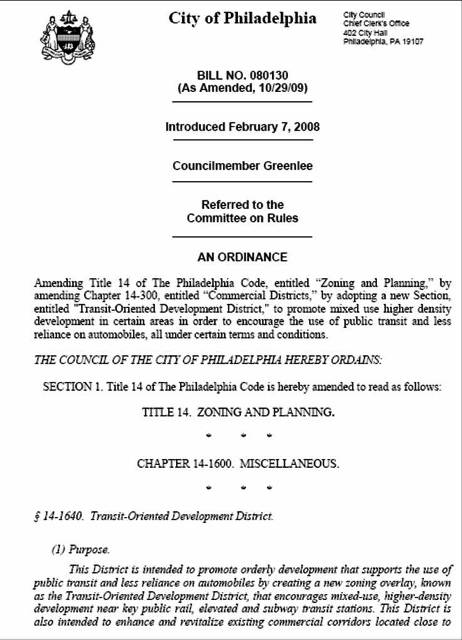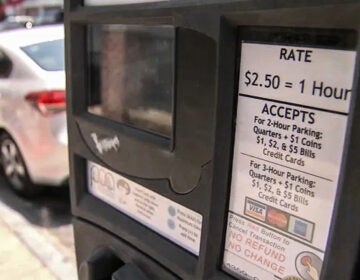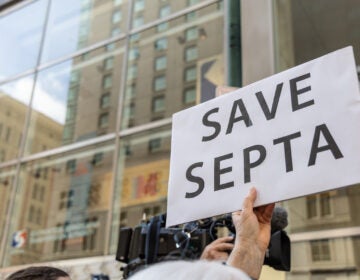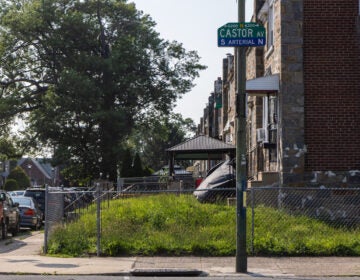Transit development overlay bill gets passed

Nov. 10
By Thomas J. Walsh
For PlanPhilly
A citywide transit-oriented development bill (TOD), which has been knocking around City Hall and the City Planning Commission since early 2008, won passage by City Council after its final reading tomorrow, Nov. 19.
That’s despite a recent recommendation from the Planning Commission to hold the bill pending further study and the imminent publication of a detailed report on TODs in Philadelphia from the nonprofit group Neighborhoods Now. The Planning Commission weighed in similarly to delay the bill earlier this year.
“I would say the budget was the main reason that this bill, and a lot of bills, took longer than what they normally would,” said City Councilman At-Large Bill Greenlee, the author of the legislation.
But there was another big reason for the delay, said Greenlee. The Planning Commissioners themselves, not the staff, was “being very – ‘careful,’ I’ll put it that way,” he said.
“They did not recommend it favorably,” Greenlee went on, referring to the Planning Commission’s October meeting. “The staff had recommended that it be approved because most of the amendments were their amendments. So to me it was a little bizarre that the staff, including the executive director, Alan Greenberger, had been working very hard on this, and we together had worked out all the details, and then the commission said, ‘Well, we need more time to study it.’ I don’t quite follow that.”
Greenlee was asked if he was aware that some of the commissioners were wary that the Neighborhoods Now report had not yet been published.
“I think maybe a little too much emphasis was put on that study,” he replied. “We were just verifying what we’ve been dealing with this whole time. We were just sort of formalizing it. Again, the commission’s own staff – probably no other entity was any more involved in this whole TOD thing than the Planning Commission staff. It would be one thing if they were just on the periphery.
“At that point, I didn’t really care what they said,” he went on. “We were gonna move the bill. We thought we had done every little bit of due diligence we could do. Whether the commission recommended it or not was, in a sense, irrelevant to me.”
The long awaited 83-page report, commissioned by Neighborhoods Now and executed by Chicago-based Farr Associates, is complete, said Beverly Coleman, a consultant and former executive director of Neighborhoods Now. It is to be released to the public on Friday (Nov. 13). Farr has “written, helped write, or [is] in the process of writing over a dozen codes across the country,” a representative told Greenlee and a City Council caucus on the matter Tuesday morning, including the cities of San Francisco, Boston, Minneapolis, Charlotte, Portland and the District of Columbia.
“The report did inform the legislation,” Coleman said. “I think it is really good interim legislation. … I’m of the philosophy that you need to keep government moving.”
Restricting the restrictions
Though it establishes a wide overlay district to both open up, and restrict, certain types of development in and around specific transit hubs, the amended bill from October 29, originally introduced by Greenlee in February 2008, is somewhat stripped-down at five and a half pages.
Gone are restrictions from the original bill that were controversial on the grounds of the class designation and income levels of certain neighborhoods, since they did not seem to be related to the definition of “transit-oriented development.” They included employment agencies, fortune telling establishments, nail salons, dollar stores, the “retail sale of used appliances,” take-out restaurants, nightclubs and laundromats.
“There were discussions with staff at the Planning Commission that helped to sponsor the bill, and other advocacy organizations, and I think those amendments helped strengthen the bill,” said Eva Gladstein, executive director of the Zoning Code Commission. “The restrictions right now appear to really try and make sure that uses that are more dependent on automobiles are restricted from transit corridors.”
The current bill prohibits primarily auto-related development, such as facilities for car sales, leasing or renting. Other prohibited new uses: car washes, outdoor advertising signs, gas stations, public and private parking lots, drive-through restaurants, and vending machines or rental kiosks that serve as the principal use of a lot.
“It’s kind of an odd duck for TOD to specifically take out something like nail salons,” said Greg Pastore, a Bella Vista property owner and a member of the Zoning Code Commission. “You’d be hard-pressed to come up with businesses in other parts of the city that are specifically banned because of their proximity to transit.”
Restricting the use of cars only makes sense, Pastore added. “You do that if you can, because it affects the economic health of the city and it serves the people who live and work in that area.”
There are also height restrictions: 45 feet in most cases, or 55 to 75 feet under certain conditions.
The gears of government
The Philadelphia City Planning Commission heard presentations on several TOD bills in February of this year, but upon the recommendation of staff, tabled its consideration until the language and timing was modified, and until the aforementioned study was being completed.
At the October meeting, the Planning Commission heard about the changes for the overlay, meant simply as an interim “guideline” – as a “Transit-Oriented Development District,” amending the commercial district portion of the existing zoning code. As Greenlee noted, this time the staff recommended that the commissioners sign off on it.
“Zoning is all about sameness, it’s all about creating a least common denominator,” said Planning Commission staffer Bill Kramer, director of the commission’s Development Planning Division. “A lot of what this represents is creating a least common denominator, so that when you go to apply it, you’ll then have to fine-tune it and make it appropriate for the individual area you want to use.”
Again, the commissioners had plenty of questions about the legislation and the sense it makes to recommend it, just as the Zoning Code Commission’s work is rounding the corner to its conclusion in 2010. Staff was instructed by the commissioners to pull together their collective concerns to be presented to City Council.
Kramer then warned them that Council had the authority to ignore the commissioners. One big issue was the absence of the Neighborhoods Now report, which was funded by the Delaware Valley Regional Planning Commission.
“This was a great example of different pieces that were not moving together,” said Natalia Olson Urtecho, who sits on both the Planning and Zoning Code commissions. “An overlay over the entire city is huge. This is too all-encompassing. There are some neighborhood characteristics that need to be taken into consideration. I understand the frustration of the City Council. But really, it’s been like, ‘Where is this report?’”
Olson Urtecho said she was just as frustrated at the slow pace of the legislation as Greenlee. Her bigger concerns are with possible job creation and money, mentioning possible federal funding via the Sustainable Communities Initiative, a joint project of the U.S. departments of Transportation and Housing and Urban Development, which first made headlines in March.
On this issue she and Greenlee are in synch. There are also billions of stimulus dollars at stake around the country, surrounding transportation initiatives from the federal government through the transportation reauthorization bill.
“A lot of this funding is going to be tied to TOD development,” Olson Urtecho said. “We have to be ahead of this – and we can be, because we as a city are the example. This (transit-based growth) is how this city was formed.”
The legislation “creates an opportunity for an area to receive the overlay,” said Gladstein. “It puts it in the Zoning Code book as a potential tool to use to foster transit-oriented development. What it does not do, though, is apply it to any place in the city.”
As convoluted as the process may have seemed to date, Gladstein agrees with Coleman and sees the legislation as a very positive educational process for the city, giving the TOD issue a higher profile. Most large American cities already have such legislation in place, Coleman noted.
“The Zoning Code Commission has not asked City Council to wait,” said Gladstein, who works out of the Planning Commission’s offices. “This notion arose quite a while ago, and I think Council is following through on its original work. At the time it was introduced it was not clear what the timelines of the Zoning Code Commission would be.”
Still, the timing has some scratching their heads.
“Are we just presuming that everything we’re doing right now is temporary?” asked Pastore. “Are we moving forward with the idea that we are going to re-work it in our own manner? You might not even need the bill, because it would be subsumed by TOD-friendly zoning.”
Then again, Pastore acknowledged, “I don’t know if City Council wouldn’t be doing their job if they didn’t want to try to get some bridge legislation.”
“What this is, is an overlay and there will be additional City Council approvals needed to re-zone – to actually re-map the overlay in the city,” Gladstein said. “I don’t know whether or not there’s an interest, or whether or not that will occur, before the overall Zoning Code reform is completed.”
“We keep using the word ‘template’ to describe the basic form of transportation-oriented development,” explained Greenlee. “Then it’s up to the individual district council person whether they want to put one in for a particular site in their district.”
The report
Farr Associates focused on seven transit stations in Philadelphia for its report, including Frankford Terminal, Snyder Station, Washington Lane and Wister Station. It performed an “in-depth study” on three others: Front & Girard Station, 46th & Market and the Temple Regional Rail Station.
PlanPhilly obtained a copy of the report to be issued Friday, on the condition it not be published in its entirely until then.
“This work is shaped by the belief that all transit stations are not the same and that a one-size-fits-all approach to zoning and development around transit stations is not sufficient to achieve high performing TOD,” it says in the introduction. “The set of standards outlined in this document are designed to promote TOD – active, inviting, pedestrian-oriented areas around transit stations that include a mix of residential, commercial, and civic uses to serve those living, working, and traveling around the station – on a variety of scales.”
Contact the reporter at thomaswalsh1@gmail.com or www.thomasjwalsh.info.
WHYY is your source for fact-based, in-depth journalism and information. As a nonprofit organization, we rely on financial support from readers like you. Please give today.






